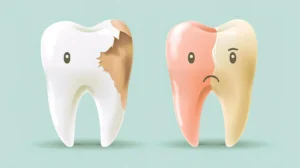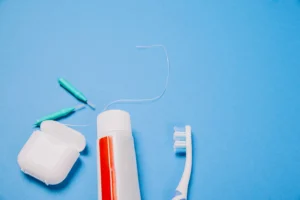Table of Contents
Restoring Teeth the Right Way
At Lockwood Family Dental in Lockwood, MT, patients often ask Dr. Brysen Hansen about the difference between dental crowns and fillings — and which treatment is best for restoring a damaged tooth.
Both options help repair and protect your teeth, but they serve different purposes depending on how much of the tooth is affected. Understanding when a filling is sufficient and when a crown is necessary can help you make informed decisions about your dental health.
In this post, we’ll explore how each treatment works, what to expect during your appointment, and how restorative dentistry can strengthen and protect your smile for the long term.
What Is a Dental Filling?
A dental filling is one of the most common restorative procedures. It’s designed to repair small areas of decay or damage before they spread deeper into the tooth.
When you come in for a filling, Dr. Hansen removes the decayed portion of the tooth, cleans the area, and fills it with a durable material such as composite resin. This restores the tooth’s structure and stops the cavity from progressing.
When Fillings Are Recommended
- Small cavities or early-stage decay
- Minor chips or cracks
- Slight wear from grinding or clenching
Fillings are quick, cost-effective, and can usually be completed in one visit. They’re ideal for maintaining natural tooth structure when the damage hasn’t reached deeper layers.
Most dental fillings can last up to 10 years with proper care, making them a reliable choice for small repairs.
What Is a Dental Crown?
A dental crown (often called a cap) is a protective covering that restores a tooth when a filling isn’t enough. Crowns are used for teeth that have lost significant structure due to decay, cracks, or previous large fillings.
At Lockwood Family Dental, Dr. Brysen Hansen customizes crowns to match your tooth color and shape, restoring both function and appearance.
When Crowns Are Recommended
- Extensive decay or structural damage
- After root canal therapy
- Broken or severely worn teeth
- To protect teeth with large fillings
- As part of a dental implant or bridge restoration
Crowns can be made from porcelain, ceramic, or other durable materials. They’re designed to last for many years and offer superior protection for vulnerable teeth.
Dental Crowns vs Fillings: Key Differences
| Feature | Dental Filling | Dental Crown |
|---|---|---|
| Purpose | Repairs small decay or minor damage | Restores major damage or weakened teeth |
| Coverage | Fills a small area | Covers the entire tooth |
| Material | Composite resin or amalgam | Porcelain, ceramic, or metal alloy |
| Durability | 5–10 years | 10–15 years or longer |
| Procedure Time | Usually one short visit | May require one or two visits (or same-day CEREC) |
| Cost | More affordable for small issues | Higher cost but longer-lasting protection |
When deciding between dental crowns vs fillings, Dr. Hansen evaluates the extent of the damage, your bite alignment, and your long-term dental goals.
What to Expect During Treatment
Getting a Filling
- Local anesthetic to numb the area
- Removal of decay and cleaning
- Placement of tooth-colored composite filling
- Polishing and bite adjustment
The process typically takes less than an hour and allows you to eat normally soon after.
Getting a Crown
- Tooth preparation (removing damaged areas and reshaping)
- Digital scan for a precise fit
- Custom fabrication of your crown
- Placement and polishing
With modern technology like CEREC same-day restorations, many crowns can be designed, created, and placed in just one visit at Lockwood Family Dental — eliminating the need for temporary crowns or multiple appointments.
Learn more in our upcoming post: 5 Benefits of CEREC Same-Day Crown Restorations
How to Know Which Option You Need
If your tooth is mildly damaged or has a small cavity, a filling may be all you need. But if the damage is extensive or the tooth has been weakened by large fillings, cracks, or decay, a crown provides the stability and protection needed to preserve your tooth for years to come.
During your exam, Dr. Brysen Hansen will take digital images and assess your tooth structure to recommend the best solution for your specific case.
Early detection of tooth decay and timely treatment with crowns or fillings can prevent root canal infections and tooth loss.
Caring for Restorations After Treatment
Whether you have a new crown or a filling, good oral hygiene habits are key to keeping your smile healthy.
Our dental team recommends:
- Brushing twice daily with a fluoride toothpaste
- Flossing around crowns and fillings daily
- Using mouthwash to reduce bacteria
- Avoiding biting down on hard foods or objects
- Visiting Lockwood Family Dental every six months for exams and professional cleanings
These simple steps help maintain your restorations and prevent new decay from forming around them.
When to Contact Lockwood Family Dental
If you experience sensitivity, pain when chewing, or notice a chipped restoration, schedule an appointment with Dr. Brysen Hansen right away. Early attention prevents further damage and ensures your tooth remains strong and functional.
You can also read more about our Restorative Dentistry services, including:
- 5 Benefits of CEREC Same-Day Crown Restorations
- Step-by-Step: What to Expect During a Dental Implant Procedure
Restore and Protect Your Smile in Lockwood, MT
Choosing between a dental crown or filling doesn’t have to be confusing. At Lockwood Family Dental, we’ll guide you through every step to ensure your treatment fits your needs, budget, and smile goals.
Dr. Brysen Hansen uses advanced materials and technology to restore function and beauty — helping you chew comfortably, speak clearly, and smile confidently.
Schedule your consultation today at Lockwood Family Dental in Lockwood, MT, and discover the right solution for your smile.



